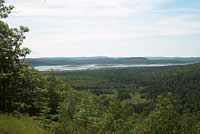Marshlands of Ontario
Conroy Marsh
 |
View Top Of Craigmont Conroy Marsh |
This unique wetland, named after Robert Conroy, who held a timber license on land west of Robinson Lake, drained by the York River, was made famous some years ago after Group of Seven member A. J. Casson depicted it on canvas. And because of its richly diverse plant and animal life, as well its beautiful setting in the majestic hills of the Madawaska Highlands, the government soon made it a Crown Game Reserve and it also was designated a new park under the Living Legacy program.
When the first lumber gangs came up the Madawaska rive from Ottawa, they encountered a great swamp where the Madawaska draining from Algonquin Park, the York, which flows out of the southern portion of Algonquin Park, winds its way through the York River Uplands, through the town of Bancroft, and into Conroy's Marsh at its mouth and Little Mississippi from the southeast.
During the early pioneer days, North American Indians would tap the soft maples in the marsh to make maple syrup. They would go over the frozen marsh to the trees in late winter and collect the syrup, maybe even using canoes after spring breakup of the ice.
When the Hillard and Dixon lumber company built a water control dam to run logs past Palmer Rapids further downstream causing the marsh water level to rise destroying the maple trees leaving nothing but their rotting stumps.
Other Marsh Business:
The Conroy Marsh teamed with wildlife. About 1916 a new business developed of shipping frog legs to New York City, Ned Lavoy would catch as many as 600 frogs per night, then clean and packed the legs in ice which were then shipped by steamer to Barry's Bay and on to New York, fetching as much as 68 dollars per night.
Around 1928, just before the great depression, Mr. Haycock of Toronto started a muskrat farm based on the marsh. Employing as many as 60 people, Haycock using chicken wire fenced up approximately 30 acres of marsh. The muskrat farm went bankrupt in 1933. There was a gossip of disappearing pelts at the end of the business, eventually the employees did get paid.
Conroy Farm:
As early as 1845, a lumbermen clear a farm at the first rapids past the swamp. Later becoming a 600 acre outpost for the hundreds of loggers working upstream, storing supplies, meat and vegetables.
The conroy farm comprised of a house, store, blacksmith shop and barn. The barn was made from 60 foot pine logs. In the early 1880's a fire consumed these buildings leaving only the carpenter shop with its roofless log walls decaying into the surrounding soil.
Shipping was expensive, therefore everything was made locally if possible. Charcoal, for the blacksmith shop was made from red pine stumps at a place across the river, the area is still called the "Charcoal Flats".
John Campbell purchased the original Conroy property in 1881 and later built a four story mansion with surrounding verandahs on two floors.
The Conroy farm was later broken up and has been owned by various residents. Today the Conroy Farm is a collection of cottages, the Silgrey Resort and the Pine Crest Cottage.
Recent History:
All sorts of wildfowl fed on marsh plants, and the Conroy Marsh is one of the best Ring-necked duck sites in Ontario.
Conroy's Marsh is a 2400 hectare wetland at the confluence of three river systems: the Madawaska, York and Little Mississippi and is a provincially significant wetland-the largest marsh complex in ecological district.
Because of its size, it's also an easy place to find yourself lost in. A couple of kilometers downstream from Conroy Rapids the waterway spreads out over 2,400 hectares, with Robinson Lake to the west and Winter Lake, Garden Lake, One Mile Bay and the mouth of the Little Mississippi River to the east. To help keep yourself on track, it's best to stay in the center of the main channel and eventually you'll meet up with Negeek Lake, where the York River flushes into the Madawaska River.
Since 1948, part of the marsh (2,100 acres)has been a Crown Game Reserve and Conroy's Marsh has been designated a conservation reserve through the Lands for Life initiative.
1956 a Hydro dam was construction at Palmer Rapids, which according to some Natural Resource wildlife expert, has environmental impart on the marsh. The stable water levels needed for the Arnprior power station doesn't match the seasonal changes needed by nature. The water levels are closely monitored to ensure the breeding needs of ducks and muskrat.
In 1962, the preserve was changed to 2 wildlife sanctuaries: one of 885 acres in Carlow Township and 748 acres in Raglan Township.
In 1982 the marsh came to public attention as wildlife conservation group Ducks Unlimited began dredging channels and constructing breeding islands for a duck breeding grounds. Which ruined sensitive riparian zones around two forested islands and along the south shore of the York River at its mouth.
All the Crown land between Egan Chute Provincial Park and Conroy's Marsh are also being added to Egan Chute Provincial Park as a waterway class park.
Since the Conroy Marsh has no commercial use, but is an excellent natural viewing environment for outdoor adventure.
